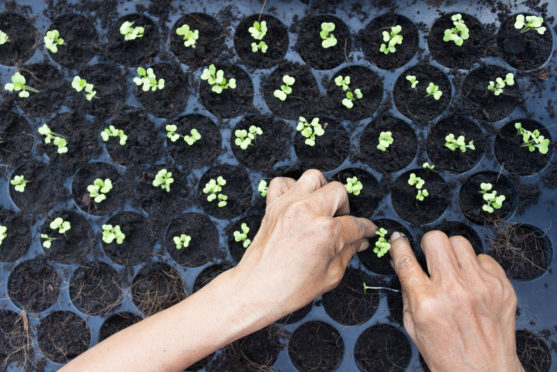
Wood anemones are wild flowers that, as well as often being planted in graveyards and parks, also have a place in the garden.
Their starry white flowers are perfect for growing around the margins of trees and shrubs. Try to give them a little bit of shade and soil that’s not waterlogged, but doesn’t dry out, and they will gradually spread out.
Seedlings that have popped up over the last week will soon need pricking out.
The best time to do this is before the first “true” leaves have developed, which means you may find yourself handling very tiny seedlings.
These will have to be moved on before they become overcrowded and to do this, you’ll need a pencil and module trays that have been filled with compost, watered and allowed to drain.
If you don’t have module trays then you can use egg boxes, planting one seedling into each cell. When it is time to plant these out you can just bury the boxes – pulling them apart to create individual plants – because the cardboard will rot down in the soil.
Use the pencil to lever out a clump of seedlings then tease these apart gently, holding them by a leaf and not by the stem.
Make a deep hole in the compost with the pencil and drop in a seedling, burying it so the entire stem is covered and only the leaves remain visible.
Use only the strongest seedlings, discarding any that are weak, then water gently and allow them to settle down for a few days before watering again.
And don’t forget to sow more seeds. The secret to keeping up an unbroken supply of greens during the summer is to keep sowing, little and often, this works for all salads and herbs such as basil, coriander and parsley.
Now is the best time to plant potatoes.
These don’t need to be “chitted” (sprouted), although many regular growers like to start them off early in this way.
Plant outdoors under 5cm of soil and earth up the stems as the plants grow.
If you are growing your potatoes in tubs or sacks, plant no more than three tubers to each container. And, however you grow your potatoes, keep an eye out for slugs.
To keep plants free from blight, keep them moist but not really damp until summer, and protect them with fleece or soil on nights when frost is forecast.
And remember that, whether you are using a greenhouse to bring on seedlings or have created your own plant protection using storage boxes or polythene sheeting, you are going to have to open it up during the day to allow air to circulate and to prevent temperatures from scorching young plants.

Enjoy the convenience of having The Sunday Post delivered as a digital ePaper straight to your smartphone, tablet or computer.
Subscribe for only £5.49 a month and enjoy all the benefits of the printed paper as a digital replica.
Subscribe